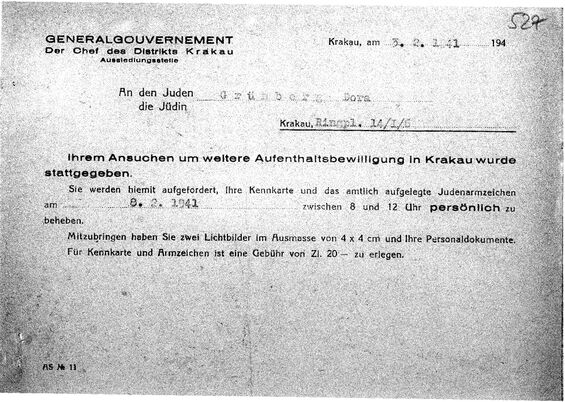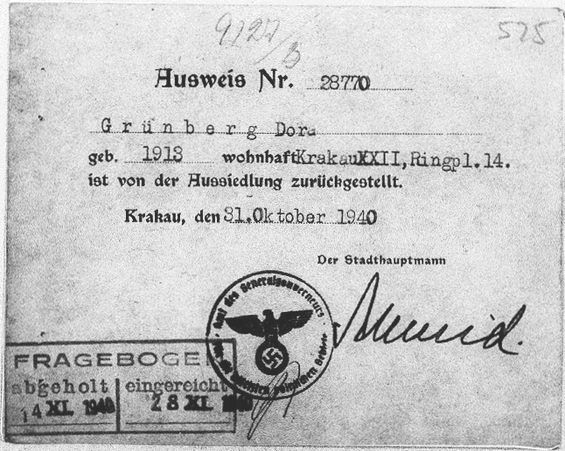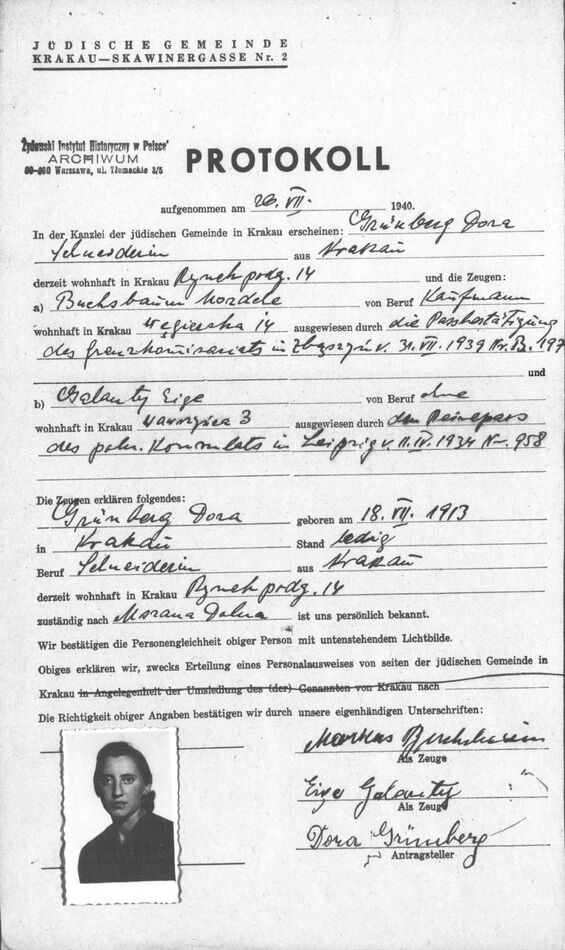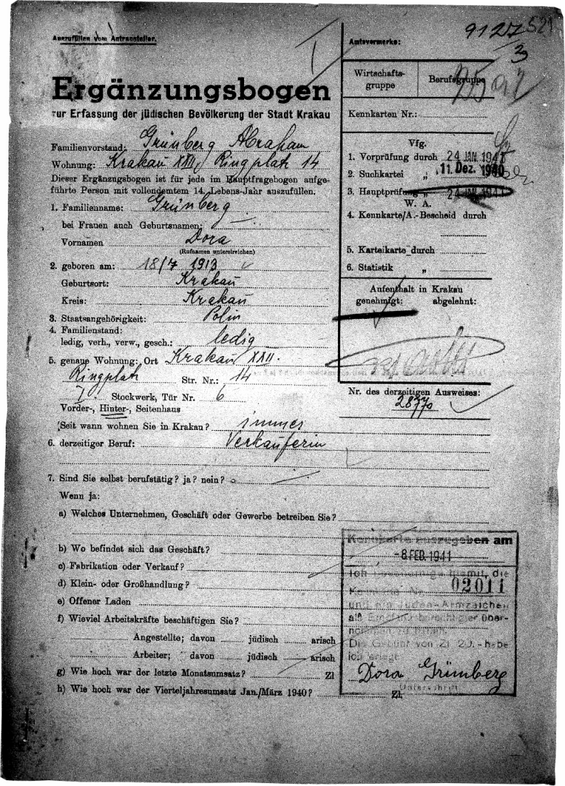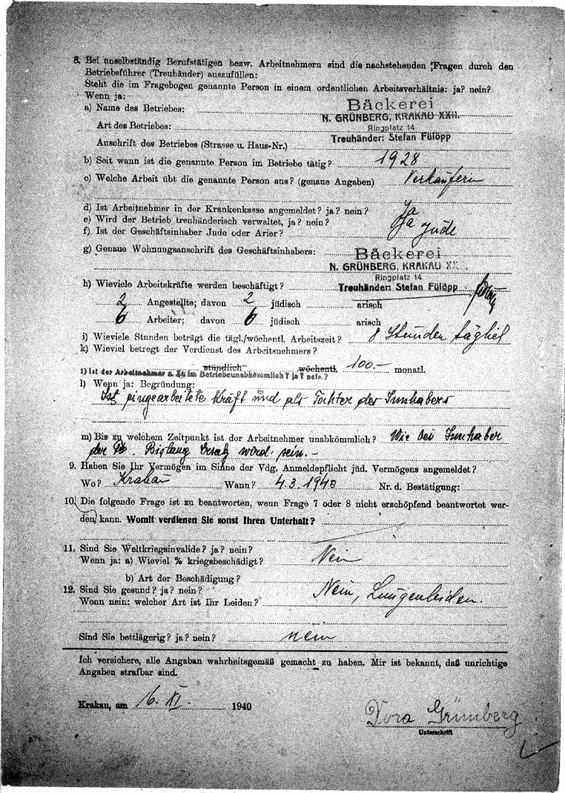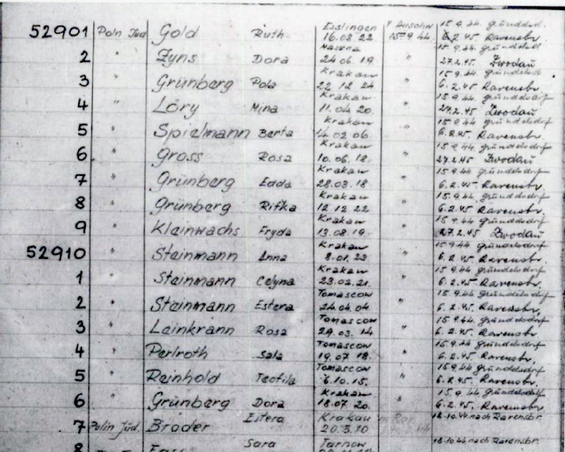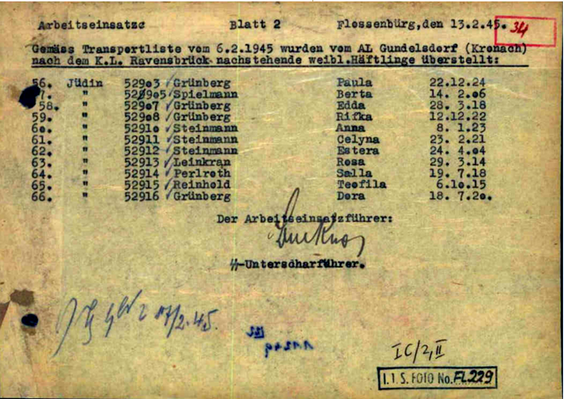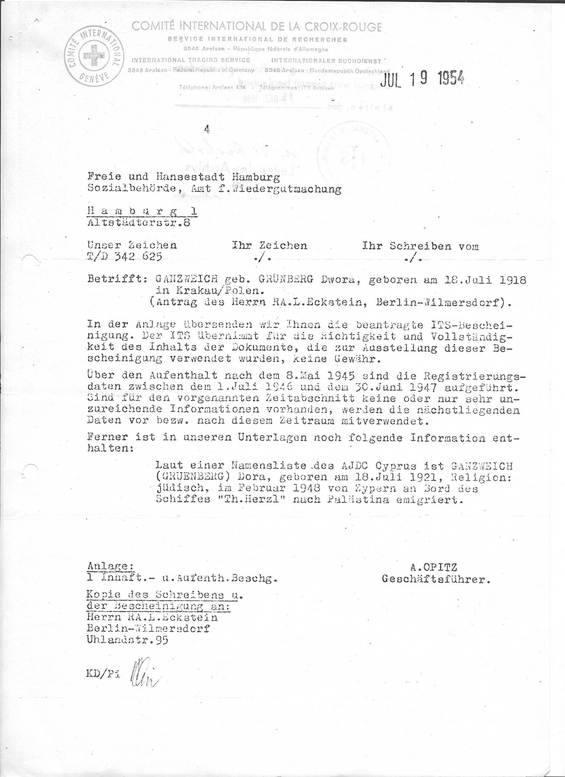The Biography of Dora Ganzweich, née Grünberg, Krakau
Short biography and stations of her persecution
- Born on 10 July 1918 in Krakow as Dora Grünberg.
- December 1939 Star of David,
- March/April 1941 - June 1942 Krakow ghetto, then in the Krakow-Plaszow forced labour camp,
- June 1944 - August 1944 Auschwitz-Birkenau concentration camp, C camp (A-19398)
- 15 Sept. 1944 Flossenbürg concentration camp/Gundelsdorf subcamp,
- 6.2.45 Ravensbrück concentration camp,
- then until 10 April 1945 in Neuengamme concentration camp/Helmstedt-Beendorf satellite camp (Note: according to information in affidavits, it was the "Hamburg-Benndorf" camp. This probably refers to the subcamp of the Neuengamme Helmstedt-Beendorf concentration camp).
- 20/21 April 1945 Neuengamme concentration camp/ Hamburg-Wandsbeck subcamp (Note: according to information in affidavits, it was the "Hamburg-Walzberg" camp. This probably refers to the stated satellite camp of Neuengamme concentration camp, where the women from Beendorf were taken after a 10-day journey. See Helmstedt-Beendorf)
- Before 5/1945 Sweden (Molarp-Glimminge camp, on 15 October 1945 in Hässleholm) Note: ITS information T/D 342 625, 9.7.1954
- 1947 Cyprus,
- February 1948 to Israel on board the ship "Th. Herzl". ITS information T/D 342 625, 9 July 1954
- 1956 USA
Dora Ganzweich lost her parents and six siblings during the persecution of the Jews by the Nazis.
Before the War
Before the outbreak of the persecution, I lived with my parents and siblings in Krakow on the market square (Rynek Podgurski 14). I was in a good and normal state of health and can't remember ever having been seriously ill. I had attended secondary school and later helped in my father's shop or stayed at home.
Unless otherwise stated, the quotations are taken from the affidavit of compensation for damage to health, ca. 1962
The beginning of the war and the ghetto
The persecution began immediately after the occupation of Krakow in September 1939. Even in the first few months we had to suffer the usual restrictions. A little later we had to wear the humiliating Jewish signs. When the ghetto was set up, I was resettled there. I had to do hard forced labour here all the time. I suffered constant harassment, hunger and fear of deportation.
I was imprisoned in the Krakow ghetto in March or April 1941. The ghetto was surrounded by barbed wire and was under German and Polish guard. I had to wear the Jewish sign on an armband and do forced labour in the bakery that had previously belonged to my father. There was a Judenrat, with Mr Biberstein as its president.
From an affidavit for damage to freedom from 1954 (available as a copy)
Documents from the Krakow ghetto
Kraków-Plaszów
I was dragged from the ghetto to the Plaszow concentration camp. I had to tailor uniforms for the German Wehrmacht for more than 12 hours a day. I was often beaten at work, especially when I made mistakes. I fell ill with constant febrile colds and suffered from pain all over my body. Medical help was out of the question.
In the summer or autumn of 1942, I was transferred to the Krakow-Plaszow concentration camp, where I had to do forced labour in a tailor shop for the Wehrmacht. The camp consisted of wooden barracks surrounded by barbed wire and guarded by SS.
From an affidavit by Dora Ganzweich for an application for compensation for loss of freedom from around 1954
The following women's labour camps/concentration camps existed in Krakow:
| Forced labour camp for Jews in the ‘Generalgouvernement’ | |
|---|---|
| Place | Kraków-Plaszów / Krakau-Plaszow |
| Designation | ’Julag I’ |
| Area | Generalgouvernement, Krakau District (1939-1944) |
| Opening | 20.08.1942 (first mention) |
| Closing | Autumn 1943 |
| Sex | Women |
| Remarks | The prisoners were assigned to the forced labour camp for Jews in Krakow-Plaszow, Jerozolimskastraße, at an unspecified point in time. |
| Quelle: deutschland-ein-denkmal.de | |
| Forced labour camp for Jews in the ‘General Government’ | |
|---|---|
| Location | Kraków-Plaszów (Jerozolimskastraße) / Krakau-Plaszow |
| Area: | General Government, Krakow District (1939-1944) |
| Opening: | early 1942 / 28.10.1942; women: 21.01.1943 |
| Closure | 11 January 1944 (conversion of the camp into a concentration camp under the SS-WVHA) |
| Prisoners | In the summer of 1943, there were about 12,000 prisoners in the camp |
| Gender: | Men and women |
| Use of prisoners at: | Kabelwerk Krakau; Julius Madritsch company, textile factory; N.K.F. (Neue Kühler- und Flugzeugteilefabriken), Kurt Hodermann |
| Type of work | Men: work in the SS economic enterprises, work in the Deutsche Emailwarenfabrik (enamel factory), work in the quarry, building barracks, road construction; Women: work in the tailor shop, work in the SS economic enterprises, work in the Deutsche Emailwarenfabrik (enamel factory), work in the munitions factory, building barracks |
| Source: deutschland-ein-denkmal.de | |
Auschwitz
After the liquidation of this camp, I was sent to Auschwitz concentration camp. My parents and six of my siblings had already been killed by this time. In Auschwitz itself, I trembled every moment before being sent to the gas chamber, as I was in a very poor state of health. In Auschwitz, the number A 19398 was tattooed on my left forearm.
I stayed in Auschwitz for a few weeks. I was taken here for some experiments. I was given injections for several days in a row and was locked in a barrack and not let out. I suffered the most excruciating pain in my abdomen. When I begged for some kind of medicine to relieve my pain, I was beaten up.
Gundelsdorf and Ravensbrück
From Auschwitz I was dragged to Gundelsdorf. Once again I was put to hard forced labour. We had to do loading work. We slept in a barrack on straw or on the bare earth. We were close to starvation.
From a file extract (transcript of an affidavit, ca. 1954)
After a short time, I was transferred to the ZAL Gundelsdorf Kommando Flossenburg. There were two large barracks here, 50 women in each barrack, where we had to sleep on straw from the bare earth. I was given prisoner's clothes and taken to a railway station for forced labour, where we had to move fully loaded wagons. I was here until about winter 1944.
The women had been forced to work for the air intelligence equipment camp I of military district VIII in Płaszów, which was relocated to Gundelsdorf. There they had to build accommodation barracks and load and unload trains. 20 women have to sew Wehrmacht uniforms for the Wiedemann company in Knellendorf.
Source: Gundelsdorf subcamp
Then I was driven to Ravensbrueck concentration camp. I didn't have to work in this camp, but I didn't get anything to eat either.
In February, 66 women are transferred to Ravensbrück concentration camp, around 20 to the Zwodau subcamp.
Source: Gundelsdorf subcamp
Helmstedt, Hamburg
Then I was driven to Hamburg-Benndorf. At that time I was more dead than alive. Shortly before I was liberated, I contracted typhus fever
When I was liberated, I was completely broken physically and mentally. As I was seriously ill, I was taken to Sweden. I stayed there until 1948 and then immigrated to Israel. I have lived in the USA since 1956.
Source: affidavit by Dora Ganzweich
Mrs G. told me that she had been in Auschwitz since August 1944. We were housed together in the C camp in Birkenau. I got the number 52929 tattooed on my left forearm, Mrs G. had No. A 19398 tattooed on her. Mrs G. was transported away from here, so we parted ways for the time being.
I met Mrs G. again in Ravensbrueck concentration camp in January 1945. After a short time, we were transferred together to ZAL Hamburg-Benndorf. We were housed together in the quarantine block. Mrs G. had typhoid fever. We were in the same barracks, just in a different room. After a few days we were taken to ZAL Hamburg-Walzberg (note: Wandsbeck). Here we were liberated together in May 1945 by the Bernadotte campaign.
From the testimony of the witness Karola G. from 1954?
Notes
Further sources
Film about the relocation of the Jewish population to the Krakow gehtto
Office for Compensation
Koblenz 1965-1972
Notes
- The application for compensation was rejected because the applicant had not resided in Germany on 1 January 1947 and did not belong to the "German linguistic and cultural group" ("Deutscher Sprach- und Kulturkreis").
Picture Credits
- Map: Oberkommando des Heeres / Generalstab, Source: Mapster, with information from Yad Vashem: "Aerial Evidence for Schindler’s List"
- RG-15.098M; Coll.: Registration forms for Jewish inhabitants of Krakow, Poland; Name list: Accepted Applications (#25039); United States Holocaust Memorial Museum Archives, Washington, DC.
- RG-15.098M; Coll.: Registration forms for Jewish inhabitants of Krakow, Poland; Name list: Accepted Applications (#25039); United States Holocaust Memorial Museum Archives, Washington, DC.
- RG-15.058M; Coll. Registration forms for Jewish inhabitants of Krakow, Poland; Name List: Protokoll (#45188); United States Holocaust Memorial Museum Archives, Washington, DC. copyright: Żydowski Instytut Historyczny im. Emanuela Ringelbluma)
- RG-15.098M; Coll.: Registration forms for Jewish inhabitants of Krakow, Poland; Name list: Accepted Applications (#25039); United States Holocaust Memorial Museum Archives, Washington, DC.
- RG-15.098M; Coll.: Registration forms for Jewish inhabitants of Krakow, Poland; Name list: Accepted Applications (#25039); United States Holocaust Memorial Museum Archives, Washington, DC.
- Quelle: KZ-Gedenkstätte Flossenbürg, Signatur: AGFl S.22.57 – Nummernbücher des Konzentrationslagers Flossenbürg, Buch 7
- Quelle:1.1.8.1/10800683/ITS Digital Archives, Arolsen Archives
- Liste Mollarp?
- Akten Konrad Kittl


